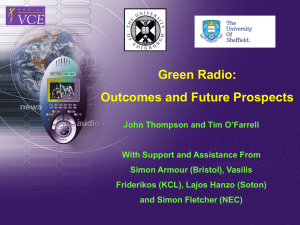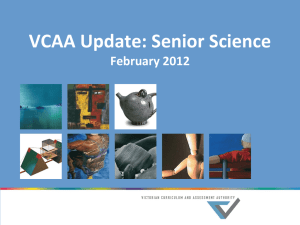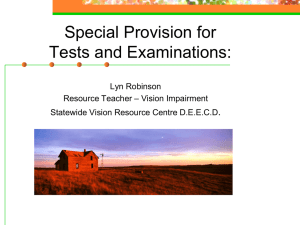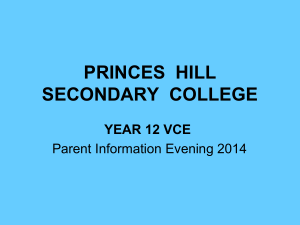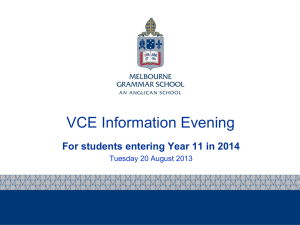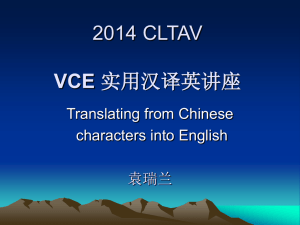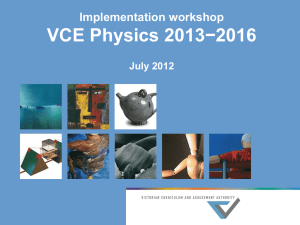mtg284Item_1503
advertisement
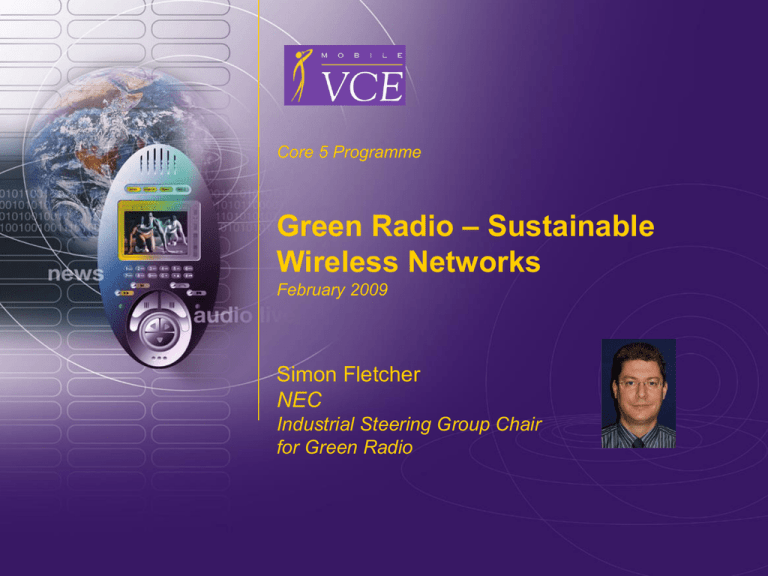
Core 5 Programme Green Radio – Sustainable Wireless Networks February 2009 Simon Fletcher NEC Industrial Steering Group Chair for Green Radio www.mobilevce.com © 2009 Mobile VCE Presentation Overview The Business Case for Green Radio Defining the Green Radio Objectives The Programme Organisation Highlights of the Research Areas Key Deliverables Conclusions www.mobilevce.com © 2009 Mobile VCE Why Green Radio? Operator & Manufacturer Perspective Increasing energy costs with higher base station site density and energy price trends A typical UK mobile network consumes 40MW Overall this is a small % of total UK energy consumption, but with huge potential to save energy in other industries Energy cost and grid availability limit growth in emerging markets (high costs for diesel generators) Corporate Responsibility targets set to reduce carbon emissions and environmental impacts of networks Vodafone1 - “Group target to reduce CO2 emissions by 50% by 2020, from 2006/07 levels” Orange2: “Reduce our greenhouse emissions per customer by 20% between 2006 and 2020” www.mobilevce.com © 2009 Mobile VCE 1. http://www.vodafone.com/etc/medialib/attachments/cr_downloads.Par.25114.File.tmp/CR%20REPORT_UK-FINAL%20ONLINE_180908_V6.pdf 2. http://www.orange.com/en_EN/tools/boxes/documents/att00005072/CSR_report_2007.pdf Where is the Energy Used? For the operator, 57% of electricity use is in radio access Operating electricity is the dominant energy requirement at base stations For user devices, most of the energy used is due to manufacturing MTX 20% CO2 emissions per subscriber per year3 9kg CO2 4.3kg CO2 Operation Embodied energy Base station 2.6kg CO2 8.1kg CO2 Mobile Data Centre 6% Core 15% www.mobilevce.com © 2009 Mobile VCE RBS 57% Retail 2% 3. Tomas Edler, Green Base Stations – How to Minimize CO2 Emission in Operator Networks, Ericsson, Bath Base Station Conference 2008 Green Radio as an Enabler Trends: Traffic Costs Diverging expectations for traffic and revenue growth Voice Data Revenue Exponential growth in data traffic Number of base stations / area increasing for higher capacity Revenue growth constrained and dependent on new services Time Energy use cannot follow traffic growth without significant increase in energy consumption Must reduce energy use per data bit carried Number of base stations increasing Operating power per cell must reduce Green radio is a key enabler for growth in cellular whilst guarding against increased environmental impact www.mobilevce.com © 2009 Mobile VCE Traffic / revenue curve from “The Mobile Broadband Vision - How to make LTE a success”, Frank Meywerk, Senior Vice President Radio Networks, T-Mobile Germany, LTE World Summit, November 2008, London 2020 Vision Paper – The Challenge The Visions Group comprising global thoughts leaders in the industry articulated the need…. “Arguably what is needed are wireless access systems that can support multimedia service data rates at two or three orders of magnitude lower transmission power than currently used. Performance of today’s radio access technologies is in fact already approaching the Shannon Bound – such an advance will not come simply from more traditional research on single aspects of the physical layer, but will require holistic, system-wide, breakthrough thinking that challenges basic assumptions” Mobile VCE consultation paper, “2020 Vision – Enabling the Digital Future” Dec’07 Mobile VCE Green Radio programme formulated to: Take forward existing research Take an international lead in this field www.mobilevce.com © 2009 Mobile VCE The Industrial Leadership Team Chairman Simon Fletcher NEC Deputy Chairman Andy Jeffries Nortel Deputy Chairman David Lister Vodafone Industry Steering Group – participants so far… www.mobilevce.com © 2009 Mobile VCE Green Radio Scenarios Two Market Profiles: 1. Developed World Developed Infrastructure Saturated Markets Quality of Service Key Drive to Reduce Costs 2. Emerging Markets Less Established Infrastructure Rapidly Expanding Markets Large Geographical Areas Often no mains power supply – power consumption a major issue Green Radio ‘Book of Assumptions’: Defines cellular, enterprise & home scenarios To galvanise targeted innovations www.mobilevce.com © 2009 Mobile VCE Academic Leadership Team Prof. Steve McLaughlin (Academic Co-ordinator) Dr. John Thompson Dr. Dave Laurenson Prof. Joe McGeehan Dr. Simon Armour Dr. Kevin Morris www.mobilevce.com © 2009 Mobile VCE Prof. Tim O'Farrell Dr. Pavel Loskot Dr. Jianhua He Prof. Hamid Aghvami Dr. Mohammad Reza Nakhai Dr. Vasilis Friderikos Green Radio Programme Organisation Industry Steering Group Energy Focus Group GR1: Architecture 2 RAs, 5 PhDs To identify a green network architecture - a low power wireless network & backhaul that still provides good quality of service www.mobilevce.com © 2009 Mobile VCE Flexible Networks Program GR2: Techniques 2 RAs, 7 PhDs To identify the best radio techniques across all layers of the protocol stack that collectively achieve 100x power reduction 2 Work Packages - 48 Man Years Target Innovations: Architecture Establishing Baselines To develop a clear understanding of energy consumption in current networks and the network elements, base sites, mobiles, etc for the scenarios defined in the Book of Assumptions Backhaul Options To determine the best backhaul strategy for a given architecture Deployment Scenarios To determine what is the optimum deployment scenario for a wide area network given a clearly defined energy efficiency metric www.mobilevce.com © 2009 Mobile VCE Target Innovations: Techniques Overall Base Station Efficiency Techniques to deliver significant improvements in overall efficiency for base stations, measured as RF power out to total input power Improving the QoS/RF Power Ratio Techniques that will reduce the required RF output power required from the base station whilst still maintaining the required QoS Optimization of a Limited Energy Budget Given a base station nominal daily energy requirement derived from renewable energy sources (eg 2.4 kWh - 100W x 24hrs) to determine how this would be best used for communication Scaling of Energy Needs with Traffic Sleep mechanisms that deliver substantial reduction in power consumption for base stations with no loads and techniques that allow power consumption to scale with load www.mobilevce.com © 2009 Mobile VCE Architecture: Technical Approach Energy Metrics & Models Primary and derived energy metrics to accurately quantify consumption Communications energy consumption models for the radio access network (RAN) architecture Energy Efficient Architectures For RAN technology, compare large versus small cell deployment Placement of relay nodes Efficient backhaul in support of identified architectures Multihop Routing Bounding energy requirements by strict end-to-end QoS Exploiting delay tolerant applications and user mobility for energy reduction Frequency Management Identification of energy efficient co-operative physical layer architecture using emerging information theory ideas to remove interference Applying Dynamic Spectrum Access (DSA) to minimize energy consumption by utilising bands with low interference Solar-powered relaying allocating resources to match combined traffic and weather patterns www.mobilevce.com © 2009 Mobile VCE Architecture: Energy Efficiency Analysis Process Macro Micro Pico Femto Step1: Large vs. small cells applying the energy metrics Step2: overlay Source & Network Coding and/or Cooperative Networking Step3: Evaluate from the following perspectives……. RRM Packet scheduling, handover, power control, load control BER/FER vs Eb/No Differentiated QoS, fast fading effects, UE speed, MIMO Link Budget Energy consumption is proportional to distance Mobility/Traffic Models UE movement, traffic types & mixes www.mobilevce.com © 2009 Mobile VCE Applying Network Element Deployment Perspective = (2) Traffic transmitted at a better time, when the mobile is closer 9 Reference Point Mobile Moves (1) Traffic held at BS to transmit at a more appropriate time Large Background Traffic Flow 2 5,7 Dedicated Wireless Link InBuilding Relay 2 2 2 E.g., Leased Line,... Radio Over Fibre 5,8 5,6 E.g., ADSL/ Cable 1 Mesh Mobile Network Fixed Relay 1,3 Public (City) WLAN Hotspot Cluster Mesh, in Coverage of the Mobile Network www.mobilevce.com © 2009 Mobile VCE 3,4 Femtocell Basestation 5,8 Mobile Relays Wide scope: Macro-cells, relays, backhaul, WLAN Consideration of Embodied Energy is required. Techniques: Power Efficient Hardware Base station efficiency Climate control 65% Power supply 85% PA / transceiver 15% Feeder cables 50% Baseline overall efficiency 4% Advanced base station architectures Integrated remote radio antenna Masthead PA eliminates feeder loss Integration avoids interconnect losses Passive thermal cooling Multi-mode and multi-standard Maximise equipment and base station re-use Integration allows energy reductions Masthead electronics to avoid cable losses Target > 20% overall efficiency Advanced power amplifier techniques Target: > 60% PA efficiency Develop envelope tracking method www.mobilevce.com © 2009 Mobile VCE Hardware Integration & Advanced PA Techniques Techniques: DSP and Radio Resource Management Interference Minimisation and Cancellation Making transmissions more robust to interference to reduce required transmit power levels Peer-to-peer communications between terminals can be exploited to share information about signals and interference to improve decoding and suppress interference RRM Techniques for Lower Power Consumption Maximising power efficient utilisation of LTE RBS co-operation and collaboration support. Robust Measurement reporting, Radio Bearer Configuration, Packet Scheduling, handover and Power and Load Control for energy efficient delivery Novel Approaches Network coding Application of Sensor network techniques, cross layer approaches grounded in Standards (LTE, WiMAX) www.mobilevce.com © 2009 Mobile VCE Green Radio Deliverables Year 1 Workshop to discuss architecture metrics and promising techniques for power reduction Executive Summary on energy and power efficiency metrics and tradeoffs Year 2 Poster day to present key results to date Reports on efficiency gains Year 3 Reports on Programme achievements for both Architectures and Techniques Work Packages Executive summaries of all key outputs from the Programme www.mobilevce.com © 2009 Mobile VCE Programme Processes to Secure Value to Industrial Members www.mobilevce.com © 2009 Mobile VCE Monthly Co-ordination Steering Group (CSG) meetings Progress management (deliverables, patents, publications) Internal and outreach event oganisation Quarterly Technical Steering Group (TSG) meetings Meetings at which all Industrials have the opportunity to engage with the Researchers in the detail of their research and get an overview of the latest technical output of the Programme Interdependent approach facilitated by well established MVCE processes with enhancements for Core 5 Encouraging exploration of synergies with Flexible Networks. Both programmes contain activities in… Network coding, routing, adaptive and self-organising techniques Webex – Internet-based interactions between Researchers and Industrials, especially valuable for overseas-based industrials WiKi - promoting high awareness of leading edge of key radio access standards LTE(-Advanced), and 802.16 (WiMAX), 802.11 (WiFi) and leading edge green technologies through the use of a WiKi knowledge base Industrial Energy Focus Group leading the embodied energy debate Energy Focus Group Concept Relate to Real World Book of Assumptions Real World Metrics Real World Costs Real World Constraints Metrics Targeted Questions Real World System Parameters Metrics / Optimisation Evaluation Approach Problem Abstraction Energy Focus Group www.mobilevce.com © 2009 Mobile VCE Terms of Reference Architecture Study Initially tightly coupled to Architecture Research Group Evolution of targeted questions Analysis abstraction for realistic industrial application What ‘energy’ metrics do we use to ensure realistic configurations & architectures result Dates for the Diary For our Members and Researchers Industry Steering Group TSG#2: 2nd April at Bristol University Education Day: 30th April at Orange Labs, Chiswick To brief the researchers on the state of the art in industry and bring everyone up to speed on the Programme. Industry Steering Group TSG#3: 2nd July at Kings College London Metrics Workshop: 9th Sept at Swansea University Review meeting for a key deliverable from the Architecture Research, all are welcome. Industry Steering Group TSG#4: 1st October - University of Edinburgh Outreach Events Event prior to WWRF: 4th May at FT-Orange, Paris Support for Femto Forum Research Day: www.mobilevce.com © 2009 Mobile VCE Aligned with the Femtocells World Summit, June 23rd - 25th, London Discussions ongoing with the Femtoforum. Conclusions Green technologies relevance to business and politics will only continue to increase, Green Radio offers timely Industry driven research. Green Radio is a 48 man year programme run over 3 years that offers… An in-depth and systematic study of architecture issues to identify trade-offs in energy efficient network design Evaluation of Techniques across the protocol stack to select most promising approaches to reduce power. Green Radio will provide insights of value to… Operators considering the impact of Green for future networks deployments Equipment Vendors for identification of key techniques enabling green solutions. www.mobilevce.com © 2009 Mobile VCE Join the Team Strong contributions from Industrials in the areas of Embodied Energy and baseline assumptions have already been received and are much appreciated If there are people in your organisations that are working in related areas please make them aware of these MVCE activities and help facilitate good information distribution within your organisations We always welcome input and active participation from our industrial members to help shape the relevance and reach out to other Research and Industrial organisations www.mobilevce.com © 2009 Mobile VCE Thank you ! Further information on mVCE contact: Dr Walter Tuttlebee, E-mail: walter.tuttlebee@mobilevce.com Tel: +44 1256 338604 WWW: www.mobilevce.com www.mobilevce.com © 2009 Mobile VCE For further information on this presentation please contact: Simon Fletcher E-mail: Simon.Fletcher@EU.NEC.COM Tel: +44 1372 381824
